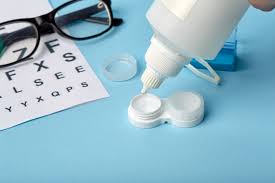
Contact Lens Safety Protects Your Eyes
Eye health is essential for your overall health and is especially important for nurses. For nurses who wear contact lenses, keeping your eyes in top shape takes some dedicated effort. The Centers for Disease Control and Prevention (CDC) has elevated the importance of contact lens care to create a Contact Lens Health Week which begins this year on August 22.
Contact lens wearers know how much of a benefit the lenses bring, but it’s easy to dismiss some of the basic health guidelines around this convenient alternative to glasses. Nurses, particularly those with long shifts, are especially prone to wearing them for long periods.
Here are a few refreshers on how to keep your eyes healthy while using contact lenses.
Maintain good hygiene
Make sure anything that touches your contact lens is meticulously clean. Wash and thoroughly dry your hands before putting your lenses in or taking them out. Rinse your case regularly with contact lens solution (not water) to help reduce the chances of bacteria contaminating your lenses, and change your case regularly. Follow all instructions for how long to wear the kinds of lenses you have (some are longer-wear hard lenses while others may have daily or two-week lenses). And always remove them before sleeping (this counts if you’re on a plane as well).
Keep them away from water
It’s easy to forget that you have lenses in when they become such a routine part of your life. But if you’re near any water–such as showering or swimming in a lake, ocean, or pool–your contact lenses should be out. Water holds all kinds of germs that are normally perfectly safe for normal use, but can introduce bacteria that can contaminate your lenses and cause a dangerous infection in your eye.
Protect your eyes
Many contact lenses have UV protection, but that doesn’t mean you’re covered. Wear sunglasses with 100 percent UVA and UVB protection when you’re outside to help your general eye health. The sun’s rays, even on overcast days and even in the watery sun of northern winters, can cause eye damage and hasten conditions including cataracts, macular degeneration, or even cancer.
Take a break
There are all kinds of guidelines around the various contact lenses available today. Be aware of the recommendations for how long you should keep yours in your eyes. If your work schedule means you leave your lenses in for long periods of time, make an effort to wear them less on your days off. Ideally one day a week that’s free of contact lens use can help your eyes, but even taking them out earlier than usual (as soon as you get home) is a healthy choice.
Be ready for a change
If you’re at work or doing something fun and your eyes begin to hurt or bother you in any way (a speck of dirt getting in your eye or allergies can cause real discomfort and irritation), be prepared to remove them and use your prescription glasses. Carry a pair of glasses with you when you leave the house so you aren’t forced to leave in uncomfortable contact lenses or to remove them and leave you with uncorrected vision. Leave a stash of solution and a lens case at work and contact lens-safe rewetting drops in your bag.
Don’t skip appointments
See your contact lens provider regularly. They will check for any vision changes and will notice any other changes in your eye. They also perform a regular assessment to see if your eyes are getting enough of the needed oxygen exchange (if contact lens overuse is your fallback, this might be an issue) that keeps them healthy.
While some tips for contact lens care can seem burdensome, getting an eye infection is not only painful and potentially dangerous, but it’s also disruptive. Being mindful of eye safety while using contact lenses will help keep them healthy.



